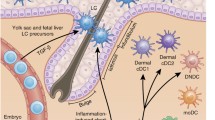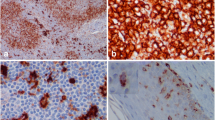Abstract
It has recently been demonstrated that CD48, which is expressed on T cells, B cells, thymocytes and splenocytes, is a ligand for mouse CD2 and that it can function as one of the costimulatory molecules in the activation of T cells. In this study, we examined the expression of CD48 on epidermal Langerhans cells (LC), which are potent antigen-presenting cells in the skin. Both freshly isolated and short-term-cultured LC were shown to express CD48 by flow cytometry. In contrast to most of the adhesion molecules expressed on LC, CD48 expression on short-term-cultured LC did not differ significantly from that on freshly isolated LC. We also examined the contribution of CD48 to antigen presentation by LC. We stimulated the myoglobin-specific T-cell clone, TK.G4, and allogeneic splenic T cells with freshly isolated LC and cultured LC, respectively, in the presence of various concentrations of anti-CD48 monoclonal antibody (mAb). Even at the concentration of 30 μg/ml, however, the anti-CD48 mAb did not show any inhibitory effects on either allogeneic or antigen-specific T-cell proliferation, whereas at a concentation 10 μg/ml, the anti-CD48 mAb significantly suppressed the proliferation of spleen cells stimulated with phytohaemagglutinin (PHA). These findings show that LC persistently express CD48, although its direct role in antigen presentation has not yet been clarified in vitro.
Similar content being viewed by others
References
Aiba S, Katz SI (1990) Phenotypic and functional characteristics of in vivo-activated Langerhans cells. J Immunol 145: 2791–2796
Aiba S, Katz SI (1991) The ability of cultured Langerhans cells to process and present protein antigens is MHC-dependent. J Immunol 146: 2479–2487
Aiba S, Nakagawa S, Ozawa H, Miyake K, Yagita H, Tagami H (1993) Up-regulation of a4 integrin on activated Langerhans cells: analysis of adhesion molecules on Langerhans cells relating to their migration from skin to draining lymph nodes. J Invest Dermatol 100: 143–147
Bierer BE, Burakoff SJ (1989) T-lymphocyte activation: the biology and function of CD2 and CD4. Immunol Rev 111: 267–294
Dustin M, Sanders M, Shaw S, Springer TA (1987) Purified lymphocyte function-associated antigen 3 binds to CD2 and mediates T lymphocyte adhesion. J Exp Med 165: 677–692
Inaba K, Schuler G, Witmer MD, Valinsky J, Atassi B, Steinman RM (1986) Immunologic properties of purified epidermal Langerhans cells. Distinct requirements for stimulation of unprimed and sensitized T lymphocytes. J Exp Med 164: 605–613
Kato K, Koyanagi M, Okada H, Takanashi T, Wong YW, Williams AF, Okumura K, Yagita H (1992) CD48 is a counter-receptor for mouse CD2 and is involved in T cell activation. J Exp Med 176: 1241–1249
Larsen CP, Ritchie SC, Pearson TC, Linsley PS, Lowry RP (1992) Functional expression of the costimulatory molecule, B7/BB1, on murine dendritic cell population. J Exp Med 176: 1215–1220
Moingeon P, Chang HC, Sayre PH, Clayton LK, Alcover A, Gardner P, Reinherz EL (1989) The structural biology of CD2. Immunol Rev 111: 111–144
Romani N, Lenz A, Glassel H, Stossel H, Stanzl U, Majdie O, Fritsch P, Schuler G (1989) Cultured human Langerhans cells resemble lymphoid dendritic cells in phenotype and function. J Invest Dermatol 93: 600–609
Sandrin MS, Mouhtouris E, Vaughan HA, Warren HS, Parish CR (1993) CD48 is a low affinity ligand for human CD2. J Immunol 151: 4606–4613
Schuler G, Steinman RM (1985) Murine epidermal Langerhans cells mature into potent immunostimulatory dendritic cells in vitro. J Exp Med 161: 526–546
Selvaraj P, Plunkett ML, Dustin M, Sanders ME, Shaw S, Springer TA (1987) T lymphocyte glycoprotein CD2 binds the cell surface ligand LFA-3. Nature 326: 400–403
Springer TA (1990) Adhesion receptors of the immune system. Nature 346: 425–434
Streilein JW, Grammer SF (1989) In vitro evidence that Langerhans cells can adopt two functionally distinct forms capable of antigen presentation to T lymphocytes. J Immunol 143: 3925–3933
Symington FW, Brady W, Linsley PS (1993) Expression and function of B7 on human epidermal Langerhans cells. J Immunol 150: 1286–1295
Takahashi H, Cease KB, Berzofsky JA (1989) Identification of proteases that process distinct epitopes on the same protein. J Immunol 142: 2221–2229
Takai Y, Reed ML, Burakoff SJ, Herrmann SH (1987) Direct evidence for a receptor-ligand interaction between the T-cell surface antigen CD2 and lymphocyte-function associated antigen-3. Proc Natl Acad Sci USA 84: 6864–6868
Tang A, Udey MC (1991) Inhibition of epidermal Langerhans cell function by low dose ultraviolet B radiation. Ultraviolet B radiation selectively modulates ICAM-1 (CD54) expression by murine Langerhans cells. J Immunol 146: 3347–3355
Teunissen MBM (1992) Functional role of adhesion molecules LFA-3 and ICAM-1 on cultured human epidermal Langerhans cells on antigen-specific T-cell activation. J Invest Dermatol 99: 77s-79s
Yagita H, Nakamura T, Karasuyama H, Okumura K (1989) Monoclonal antibodies specific for murine CD2 reveal its presence on B as well as T cells. Proc Natl Acad Sci USA 86: 645–649
Author information
Authors and Affiliations
Rights and permissions
About this article
Cite this article
Ozawa, H., Aiba, S., Nakagawa, S. et al. Murine epidermal Langerhans cells express CD48, which is a counter-receptor for mouse CD2. Arch Dermatol Res 287, 524–528 (1995). https://doi.org/10.1007/BF00374070
Received:
Issue Date:
DOI: https://doi.org/10.1007/BF00374070




